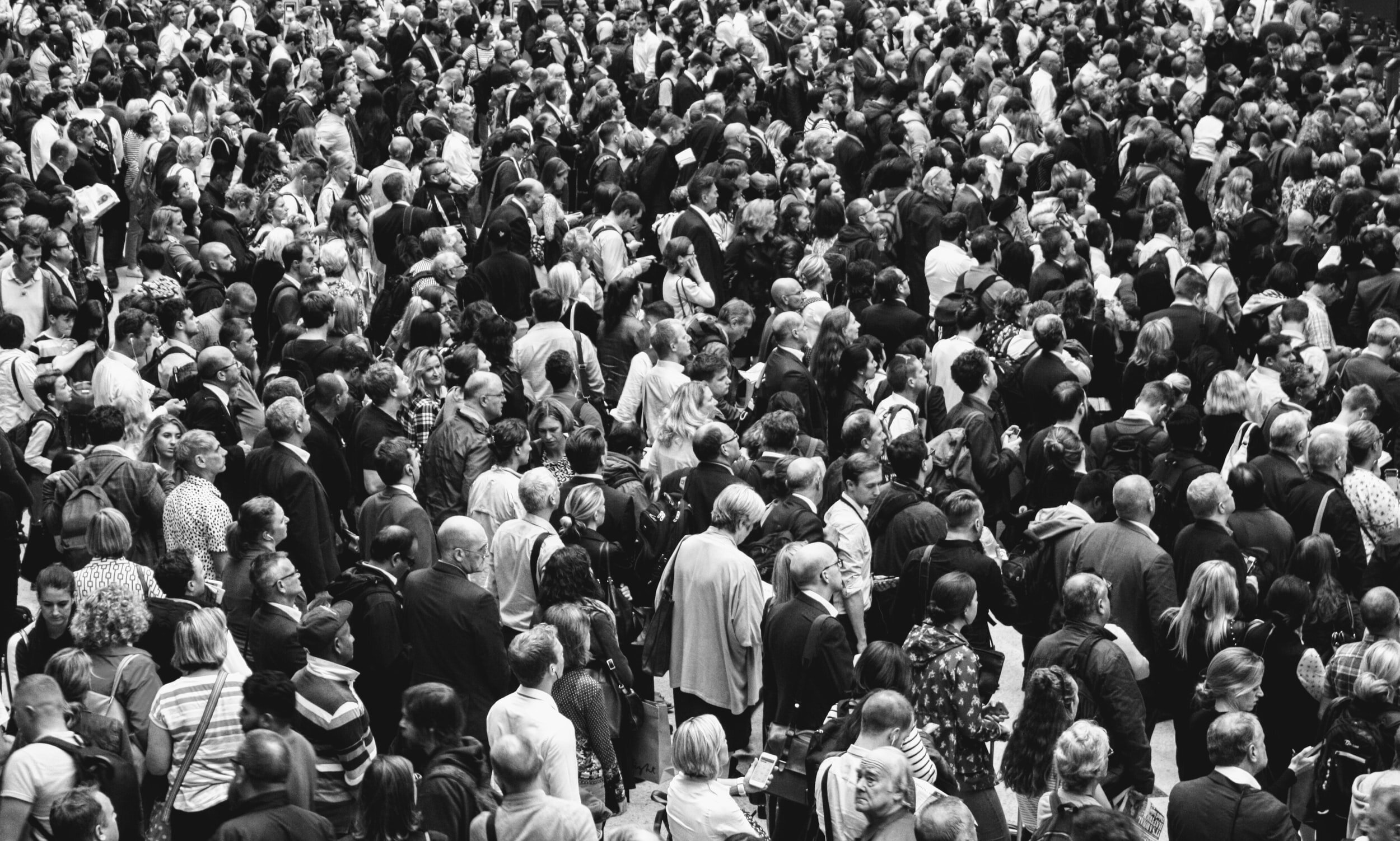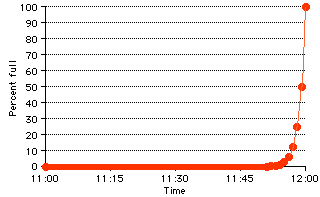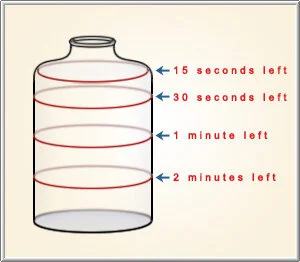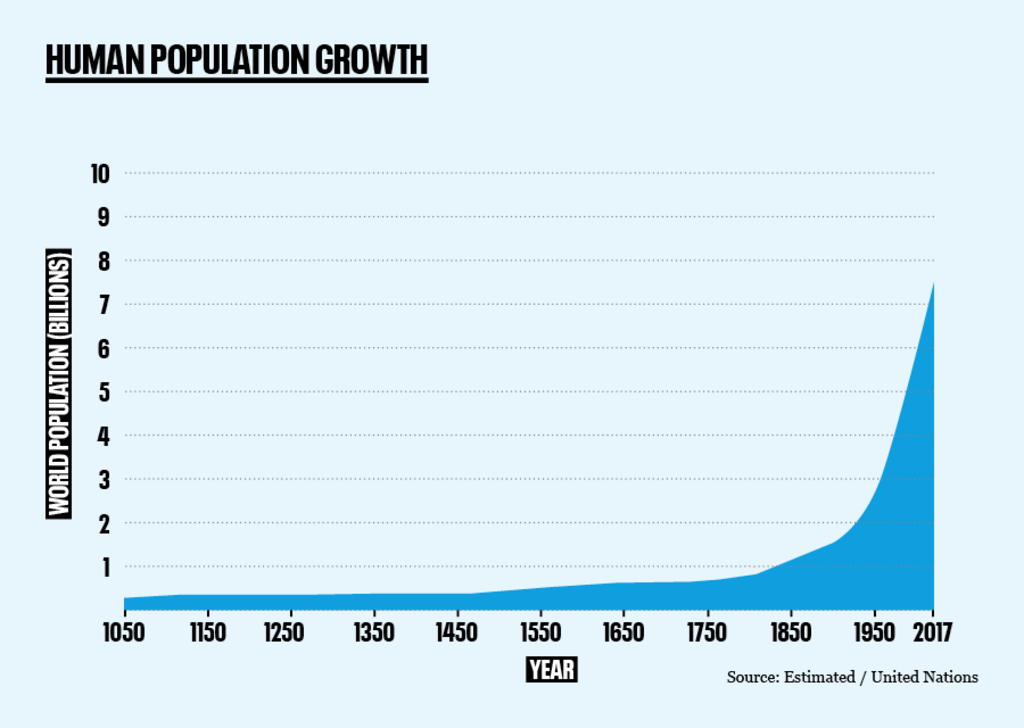
Understanding Exponential Growth
When most people talk about "growth", they consider it a completely positive and necessary thing, essential for maintaining the vitality and health of our economies and societies.
Many nations' most revered economic indicators are all based on this fundamental idea: that continuing growth is vital for the health and preservation of the economy and the social fabric of the country. In fact, growth is pretty much the only thing they measure!
However, natural scientists (such as biologists, chemists, and physicists) know that this assumption must be false. In order for growth to continue forever, we would need an infinite amount of space, energy, and other resources to keep the growth going... and those resources are not infinite.
So what happens to steady growth in a limited space? To help explain, we're going to use a simple example of bacteria growing in a bottle.
Let's say that these bacteria have all the food they need. In this story, the only limits to the bacteria's growth are the walls of their bottle.
11:00 The Beginning
At 11:00, we place a single bacterium in a bottle. It's so small you'd need a microscope to see it!
11:01
In one minute it grows to twice its original size and divides in half, reproducing itself, so at 11:01 there are two bacteria in the bottle.
11:02 and 11:03
The bacteria continue growing and dividing, doubling their numbers every minute, so by 11:02 there are four, and by 11:03 there are eight.
(They're not getting smaller; we're just zooming out so we can see them all. Each bacterium is as big as the original one was.)
11:04 and 11:05
At the end of five minutes, there are 32 bacteria where there used to be just one ... but even all together they're still so small they can't be seen without a microscope.
12:00
The bacteria keep doubling their numbers every minute, until 12:00, when the bottle fills up.
Question #1
When do you suppose the bottle was half full?
About 11:30? Almost 12:00?
About 11:30
Was the bottle half full at 11:30?
That would be the correct answer... if the bottle filled the same amount every minute. For instance, if we were filling it from a dripping water faucet, the bottle would be 1/4 full after 1/4 of the time, half full after half the time, and completely full after all the time had passed.
But that's not what's going on here, because the bacteria double their numbers every minute.
Almost 12:00
The bottle was half full of bacteria much closer to 12:00. How much closer?
11:57? 11:58? 11:59:?
11:57
Would you believe that at 11:57, the bottle was only one eighth full?
Think of it this way... if the bottle is half full and the bacteria double every minute, then in the next minute the bottle will fill up... and we know it filled up at 12:00.
11:58
Would you believe that at 11:58, the bottle was only one fourth full?
Think of it this way... if the bottle is half full, and the bacteria double every minute, then in the next minute the bottle will fill up... and we know it filled up at 12:00.
11:59!
That's right! At 11:59, the bottle is half full!
Since the bottle filled up at 12:00, it must have been half full just a minute before.
At 11:45 we could just barely see the bacteria, and at 11:30 we still needed a microscope!
Exponential Bacterial Growth Graphed
The bacteria's growth over time can be graphed like the red line on this graph:
This is called "exponential" growth. Many people have trouble understanding exponential growth, because we're used to things growing "linearly" -- the same amount from one day to the next, like hair or grass or fingernails.
We expect the bottle to fill with bacteria as if we were filling it with water from a faucet. But any time living things are allowed to reproduce freely, their numbers increase exponentially, not linearly. And when people talk about "steady growth," they mean exponential growth then, too.
The final minutes
If you were one of the bacteria, when do you suppose you'd start to worry about overcrowding?
Would that leave you enough time to do anything about it?
Question #2
Now imagine that just before 12:00, we bring in three more bottles.
If we can help the bacteria to spill over into the other bottles, they'll have four times as much space as they've ever had before!
How much time after 12:00 do you think this will give them?
3 hours? 30 minutes? 15 minutes? 2 minutes? 1 minute?
3 Hours
No, they'll fill all the bottles in a lot less time than three hours.
Remember, they double every minute.
30 minutes
No, they'll fill all the bottles in a lot less time than half an hour.
Remember, they double every minute.
15 Minutes?
No, they'll fill all the bottles in a lot less time than 15 minutes.
Remember, they double every minute.
12:01 - 1 minute later
By 12:01 the bacteria in the first bottle have doubled to fill the second bottle.
12:02 - 2 minutes Later
At 12:02, all four bottles are full!
Conclusion
A number of aspects of our environmental situation are similar to the bacteria's situation in this story.
- the human population of the world has doubled twice in the past hundred years.
- Energy consumption is doubling about four times faster than that.
- The number of automobiles in the world is doubling ten times faster than population!
The Rule of 70
There's an easy way to figure out how quickly something will double when it's growing exponentially. Just divide 70 by the percent increase, and you've got the doubling time.
| The Rule of 70 |
| 70 / % growth = doubling time |
| 70 / doubling time = % growth |
It works in reverse, too: divide 70 by the doubling time to find the growth rate. If you hear that a population is due to double in 70 years, you know that it's increasing at 1% per year (70/70=1). Isn't it amazing that just a 1% annual increase can cause a doubling in 70 years?
Remember this "Rule of 70" whenever you hear that something is growing by some percentage, or that something is growing steadily. That means it's going to double -- and probably sooner than you think!
Another Look
When our consumption of a resource (oil for instance) grows steadily, the doubling time takes on an even scarier meaning: during that time we use up more of the resource than in all of history before that time!
To understand why this is the case, think of the bacteria again. Every minute, there are more of them alive than the sum of all those that lived before that time.
So if we keep increasing our oil consumption like this, we'll use more oil in the next 50 to 75 years than we've produced in all of history up to now! Where will we get that much oil? What impact will it have on our climate and whole environment?
| Time | Number Alive | * | Previous Total |
| 11:01 | 2 | ** | 1 |
| 11:02 | 4 | **** | 1+2 = 3 |
| 11:03 | 8 | ******** | 1+2+4 = 7 |
| 11:04 | 16 | **************** | 1+2+4+8 = 15 |
| 11:05 | 32 | ******************************** | 1+2+4+8+16 = 31 |
The Impossibility of Infinite Growth
There are those who say we don't need to worry about running out of resources such as inexpensive oil, because there's still lots of oil left in the ground. Experts believe that over the past 150 years we have used up about half the total oil on Earth. In other words, our oil supply "bottle" is still half full. But, if we keep doubling our consumption, all the remaining petroleum will only last for one more doubling - and get increasingly expensive and polluting in the process! So what time does that make it in our "bottle"? 11:59!
The Only Sustainable Solution - Stop Growing
Others say we don't need to worry because we'll find other sources of energy. This is like the bacteria discovering other bottles to grow into -- as long as we keep doubling our consumption, _no_ amount of new energy will meet our needs for more than a few years.
The only sustainable solution is to stop growing.
Human Population Growth
For most of recent history, human population has been growing exponentially, and we are still increasing by nearly 10,000 people per hour -- over 80 million people each year. Many thousands of concerned people want to avoid global catastrophe. So they are working to achieve a more sustainable world population level. A smaller world population is essential in creating a better balance with the world's declining, vital resources and preserving the natural world we humans can't live without.
Let's Work Together to Achieve a Sustainable Population Future
The really important question is: how will world population stop increasing? Will births decrease or will deaths increase -- more famines, diseases, wars, and suffering?
The United Nations predicts that if we really work at it -- harder than we ever have -- we could stop population growth by 2060 by further reducing birth rates.
If we got really ambitious and achieved a 1 child average per family we could stop growing world population in about 20 years - and reduce world population to around 3 billion within 100 years! That would be a great victory for humanity's future and the future of all other species we share the planet with!
Why Should We Work to Create a Sustainable Population?
Why should we work at it? Because already, with over 7.8 billion people (in 2021), we're doing permanent damage to our land, water, and energy supplies -- and the amount of damage we do keeps increasing with our numbers.
If the Earth is unable to sustain all of us 7.8 billion people at an acceptable standard of living, how can we hope to sustain 9 billion or 11 billion? How can we hope to improve the poorest peoples' standard of living when there's less of everything to go around, the climate is chaotic, and the planet polluted?
The sooner we stop growing, the better chance we have of avoiding worldwide famines and other catastrophes.
"The greatest shortcoming of the human race is our inability to understand the exponential function."
Dr. Albert A. Bartlett
Former Advisory Board Member
Population Balance
Ready for more? View a series of videos by Al Bartlett that explain Exponential Human Growth























